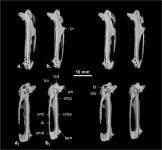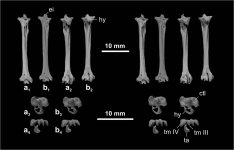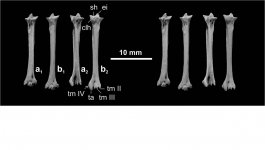Fred Ruhe
Well-known member

Kenneth E. Campbell, Jr. & Zbigniew M. Bochenski, 2021
A review of the woodpeckers (Aves: Piciformes) from the asphalt deposits of Rancho La Brea, California, with the description of three new species
Palaeobiodiversity and Palaeoenvironments. in press.
doi:10.1007/s12549-020-00444-1
Abstract: https://link.springer.com/article/10.1007/s12549-020-00444-1
A review of the piciform avifauna from the upper Pleistocene asphalt deposits of Rancho La Brea, Los Angeles, California, reveals that it comprises at least six species in five genera. We describe a new genus and species, Breacopus garretti, for the largest woodpecker, which was similar in size to the largest living North American species, Dryocopus pileatus. We recognise a new genus and species, Bitumenpicus minimus, for the smallest woodpecker in the palaeoavifauna of Rancho La Brea. We also recognise a new species of Melanerpes, M. shawi. The most common species present in the asphalt deposits is the Northern Flicker, Colaptes auratus, which is predictable because of its ground-foraging habits, which would bring it into contact with the surficial seeps of petroleum more often than those piciforms preferring an arboreal habitat. Habits of the extant species from Rancho La Brea suggest a primarily open environment, with the largest species suggesting the presence of at least scattered large trees. The piciform palaeoavifauna provides support for the hypothesis that southwestern California was a “biogeographic island,” or a region where the insular nature of the habitat promoted speciation during the late Pleistocene.
Enjoy,
Fred
A review of the woodpeckers (Aves: Piciformes) from the asphalt deposits of Rancho La Brea, California, with the description of three new species
Palaeobiodiversity and Palaeoenvironments. in press.
doi:10.1007/s12549-020-00444-1
Abstract: https://link.springer.com/article/10.1007/s12549-020-00444-1
A review of the piciform avifauna from the upper Pleistocene asphalt deposits of Rancho La Brea, Los Angeles, California, reveals that it comprises at least six species in five genera. We describe a new genus and species, Breacopus garretti, for the largest woodpecker, which was similar in size to the largest living North American species, Dryocopus pileatus. We recognise a new genus and species, Bitumenpicus minimus, for the smallest woodpecker in the palaeoavifauna of Rancho La Brea. We also recognise a new species of Melanerpes, M. shawi. The most common species present in the asphalt deposits is the Northern Flicker, Colaptes auratus, which is predictable because of its ground-foraging habits, which would bring it into contact with the surficial seeps of petroleum more often than those piciforms preferring an arboreal habitat. Habits of the extant species from Rancho La Brea suggest a primarily open environment, with the largest species suggesting the presence of at least scattered large trees. The piciform palaeoavifauna provides support for the hypothesis that southwestern California was a “biogeographic island,” or a region where the insular nature of the habitat promoted speciation during the late Pleistocene.
Enjoy,
Fred






